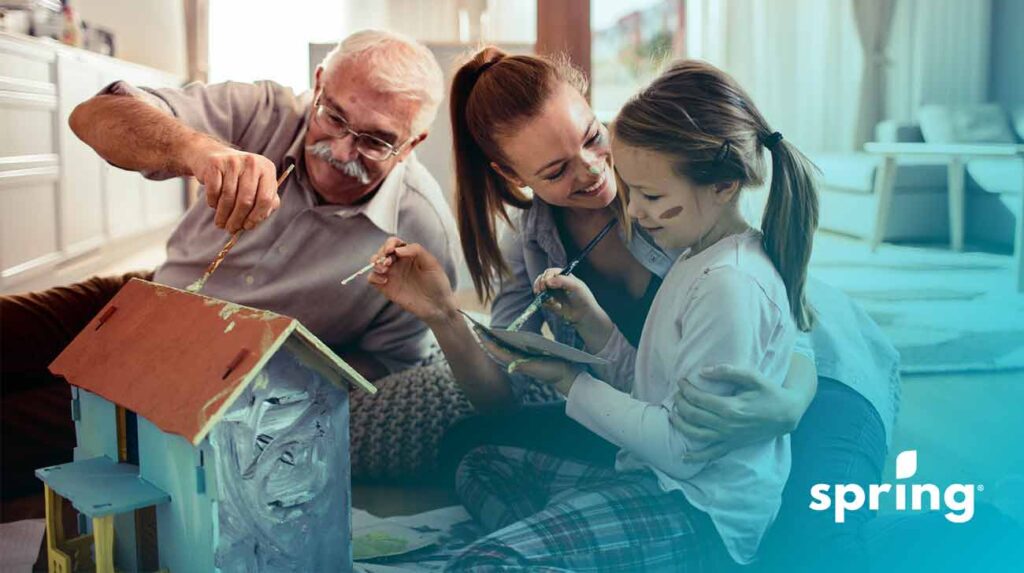You must meet the required qualifications to qualify for this new refundable tax credit as the person claiming. Once you qualify, the amount you receive as a tax credit is based on your spending.
How The Credit Works
In order to qualify for this tax credit, you need to show total qualifying expenditures for a qualifying renovation. However, you may be wondering what’s considered a qualifying renovation. A qualifying renovation creates a secondary unit (self-contained housing unit) that will be a living arrangement for a qualifying individual or a qualifying relative.
While this can be done using existing living space and an existing structure, the secondary housing unit must be enduring (not temporary) and have its own entrance, which is also considered a private entrance. It can be attached to the main living area or detached as long as it’s a housing unit located on the property and has a separate sleeping area. That said, it’s usually limited to half a hectare of eligible land for the dwelling.
According to the federal government’s Canada Revenue Agency, a qualifying individual who is 65 or older by the end of the tax year. A qualifying individual can also be an individual who is 18 years old or older, and an amount is deductible under the disability tax credit. A qualifying relation (qualifying family member), however, is someone who is at least 18 years old by the end of the taxation year and considered the following of the qualifying individual or the qualifying individual’s cohabitating spouse/common-law partner:
- Parent
- Child
- Grandparent
- Grandchild
- Brother
- Sister
- Aunt
- Uncle
- Niece
- Nephew
Another requirement that must be met before the credit is approved is that all renovations must be approved and meet applicable local requirements. This means that all permits were done, and inspections were passed. Any expenses claimed under the Medical Expenses Tax Credit won’t be eligible for the MHRTC, and only one qualifying renovation can be claimed for the lifetime of the qualified individual.
When you file for the MHRTC, the eligible individual or eligible family member ordinarily resides or intends to reside in the newly constructed secondary dwelling unit within 12 months from the end of the renovation period. The credit must be claimed, though, in the same tax year that the renovations were completed.
How To Apply For The Credit
When you’re looking to claim the MHRTC, it’s important to note that you claim the renovation in the tax year that it’s completed not in the tax year that the renovation was started. However, it’s not as much of an application as it is an amount on your income tax return. You enter this amount on line 45355. It’s also important to note that you can claim more than one renovated dwelling per year.
In order to prove that you are in fact eligible for the credit, you need to provide supporting documents for the renovation period tax year. These include:
- Information that identifies the vendor and or contractor
- Description of the goods and the purchase dates
- The date the goods were delivered
- Description of work done
- The amount of the invoice
- Proof of payment
Essentially, you can include proof and claim eligible expenses related to the small separate house or new secondary unit. While this doesn’t have to be separate from the primary unit, it does have to have a separate entrance.
Another thing to consider when applying for the new tax credit for the renovation period taxation year is that the credit can be split between two or more individuals who share the cost of renovation as long as they meet the requirements:
- Each is considered an eligible individual
- The total claimed is not more than the maximum amount
- Both of the eligible individuals can only claim what they paid for
- Nothing was previously claimed for the qualifying individual
How The MHRTC Is Calculated
The simplest way to calculate the MHRTC is to use the Schedule 12 form. There’s an updated form on the CRA website for each tax year that you can use to calculate the tax credit. However, while you can do multiple tax credits for each tax year, you can have only one MHRTC claim for the same relative that qualifies. However, if you do multiple renovations for multiple adult children, then you can claim the credit more than once.
Home Renovations in Canada That Are Tax Deductible
When it comes time to claim your renovations, it’s important to know which renovation expenses you’re able to claim for the renovation project. Here’s a list of common eligible expenses:
- Building materials
- Equipment rentals
- Permits
- Labour by qualified professionals such as plumbers and electricians
Unfortunately, the list of what you’re not able to claim is actually longer. These include the following expenses:
- Household appliance purchases
- Security monitoring
- Outdoor maintenance
- Your own time and labour
- Routine maintenance
It’s important to have a receipt for any expenses that you choose to claim. Without a receipt, you cannot claim the expense. You’ll also need vendor names, business addresses, and GST/HST numbers. to claim. Without a receipt, you cannot claim the expense. You’ll also need vendor names, business addresses, and GST/HST numbers.

How Much Can You Get From the MHRTC?
How much you receive as a refundable credit from the Multigenerational Home Renovation Tax Credit is based on the amount you claim in qualifying expenses. Essentially, the lowest tax rate of 15% is multiplied by $50,000 or the amount of qualifying expenditures incurred, whichever is lower. That said, if the qualifying individual wasn’t a Canadian resident throughout the tax year, then the amounts won’t qualify.
Home Renovation Tax Credits Per Province
Depending on where you live in Canada, the Multigenerational Home Renovation Tax Credit isn’t the only renovation tax credit available for Canada owned property. In addition to the federal tax credit from the Canadian government, some provinces also offer a provincial tax credit. Currently, these provinces include British Columbia, Quebec, and New Brunswick. There also used to be a credit from Ontario, but it’s no longer available.
British Columbia
In BC, the Home Renovation Tax Credit is available for seniors 65 and over and those with disabilities. This credit covers the cost of certain home renovations that make the home more functional and/or improve accessibility. In order to be eligible for this tax credit, you must meet the following eligibility requirements by the last day of the tax year:
- Be a BC resident
- Be a senior or a family member who lives with a senior
- Be a person with a disability or live with a person with a disability
The great thing about this credit is that if you’re eligible for the disability tax credit, then you’re eligible for this credit. How much you can receive for this credit is based on how much you spend, but essentially, you get 10% back up to $1,000. This means you can claim up to $10,000 while receiving the tax credit. Also, the credit can be claimed by multiple people in the home, but the maximum amount will be the same for the household, not each person.
Qualifying Renovations
When it comes to claiming your renovations on your taxes, it’s important to know which renovations are and aren’t included with the credit.
| Renovations That Qualify | Renovations That Don’t Qualify |
| Walk in bathtubs | Aesthetic enhancements |
| Lowering or installing adjustable countertops | All appliances |
| Widening of doorways | Fire extinguishers |
| Simple door locks | General maintenance |
| Touch and release drawers and cupboards | Regular flooring installation |
| Non-slip flooring | Heating or air conditioning systems |
| General accessibility financing costs | electronics |
| Grab bars in the bathroom | Home medical monitoring systems |
| Wheelchair ramps | Home security systems |
| Raised toilets | Insulation replacements |
| Hands-free or relocation taps | Roof repairs |
| Lowering sinks | Adapted vehicles |
| Wheel in showers | Walkers |
| Pull out shelves | Wheelchairs |
| Lever handles | Window installation |
| Accessible and motion-activated lights | Home services provided like home care |
| Handrails | Outdoor maintenance |
Quebec
In Quebec, a provincial tax credit similar to the Home Renovation Tax Credit is called the Independent Living Tax Credit. Seniors who are 70 years old or older by the end of the tax year are eligible as long as they meet specific criteria. The idea behind it is to reduce the cost of rent and any expenses related to home support.
The amount you receive from this tax credit is based on your spending. Essentially, you’ll receive 20% back of all expenses for the purchase, lease, or installation of equipment or fixtures, as well as expenses spent on one or more stays in a functional rehabilitation transition unit. It’s important to note that the first $250 purchase, lease, or installation is not eligible. You or your spouse must also have paid for the expenses.
New Brunswick
In New Brunswick, seniors can also receive a provincial tax credit for home renovations. You must be at least 65 years old or live with someone 65 or older and claim renovation costs related to making your home more accessible and safer. You must also be a resident of New Brunswick.
With this tax credit, you can claim up to a maximum of $10,000 and receive a refundable tax credit of up to a maximum credit of $1000. This credit has been available since the 2015 tax year, and expenses can be claimed from as far back as then.
Final Thoughts
If you have aging parents who live with you or someone else, such as a cohabiting spouse, who has a disability and qualifies for the disability tax credit, you could qualify for some home renovation tax credits. There’s the MHRTC, which is a federal credit, and some provincial tax credits, depending on where you live.
To qualify for these tax credits, the renovations have to be considered qualifying renovations. The renovations that qualify need to be imperative to the eligible individual’s residence and comfort. The federal tax credit covers costs related to an eligible dwelling, which can include a basement suite or even a carriage house. No matter which credit you’re applying for, though, in order to receive that tax credit, you do need to have all of your receipts. If you’re unsure if you qualify, it’s best to talk to an accountant or tax professional.








